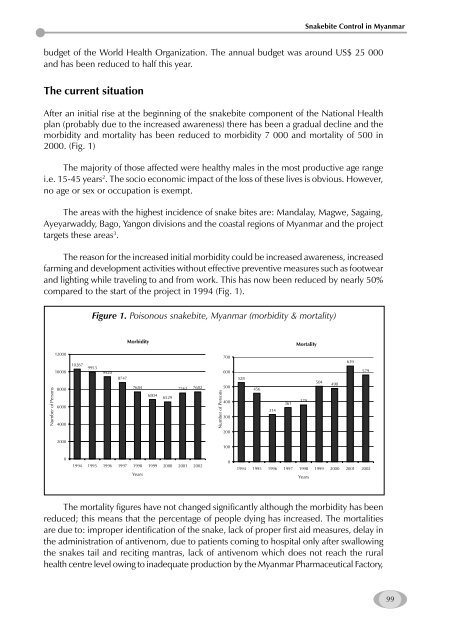Management of Snakebite and Research Management of Snakebite ...
Management of Snakebite and Research Management of Snakebite ...
Management of Snakebite and Research Management of Snakebite ...
You also want an ePaper? Increase the reach of your titles
YUMPU automatically turns print PDFs into web optimized ePapers that Google loves.
udget <strong>of</strong> the World Health Organization. The annual budget was around US$ 25 000<br />
<strong>and</strong> has been reduced to half this year.<br />
The current situation<br />
After an initial rise at the beginning <strong>of</strong> the snakebite component <strong>of</strong> the National Health<br />
plan (probably due to the increased awareness) there has been a gradual decline <strong>and</strong> the<br />
morbidity <strong>and</strong> mortality has been reduced to morbidity 7 000 <strong>and</strong> mortality <strong>of</strong> 500 in<br />
2000. (Fig. 1)<br />
The majority <strong>of</strong> those affected were healthy males in the most productive age range<br />
i.e. 15-45 years 2 . The socio economic impact <strong>of</strong> the loss <strong>of</strong> these lives is obvious. However,<br />
no age or sex or occupation is exempt.<br />
The areas with the highest incidence <strong>of</strong> snake bites are: M<strong>and</strong>alay, Magwe, Sagaing,<br />
Ayeyarwaddy, Bago, Yangon divisions <strong>and</strong> the coastal regions <strong>of</strong> Myanmar <strong>and</strong> the project<br />
targets these areas 3 .<br />
The reason for the increased initial morbidity could be increased awareness, increased<br />
farming <strong>and</strong> development activities without effective preventive measures such as footwear<br />
<strong>and</strong> lighting while traveling to <strong>and</strong> from work. This has now been reduced by nearly 50%<br />
compared to the start <strong>of</strong> the project in 1994 (Fig. 1).<br />
Number <strong>of</strong> Persons<br />
12000<br />
10000<br />
8000<br />
6000<br />
4000<br />
2000<br />
0<br />
10287<br />
Figure 1. Poisonous snakebite, Myanmar (morbidity & mortality)<br />
9953<br />
9420<br />
8747<br />
Morbidity<br />
7684<br />
6804<br />
6529<br />
7562 7682<br />
1994 1995 1996 1997 1998 1999 2000 2001 2002<br />
Years<br />
<strong>Snakebite</strong> Control in Myanmar<br />
The mortality figures have not changed significantly although the morbidity has been<br />
reduced; this means that the percentage <strong>of</strong> people dying has increased. The mortalities<br />
are due to: improper identification <strong>of</strong> the snake, lack <strong>of</strong> proper first aid measures, delay in<br />
the administration <strong>of</strong> antivenom, due to patients coming to hospital only after swallowing<br />
the snakes tail <strong>and</strong> reciting mantras, lack <strong>of</strong> antivenom which does not reach the rural<br />
health centre level owing to inadequate production by the Myanmar Pharmaceutical Factory,<br />
Number <strong>of</strong> Persons<br />
700<br />
600<br />
500<br />
400<br />
300<br />
200<br />
100<br />
0<br />
528<br />
456<br />
314<br />
361<br />
Mortality<br />
379<br />
504<br />
490<br />
639<br />
579<br />
1994 1995 1996 1997 1998 1999 2000 2001 2002<br />
Years<br />
99









